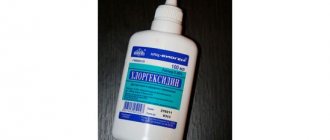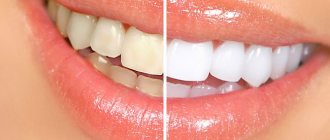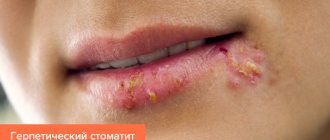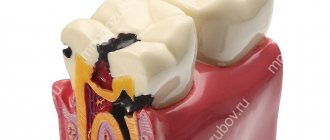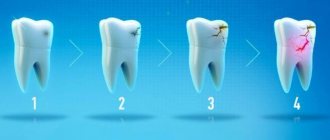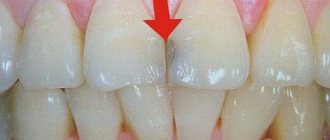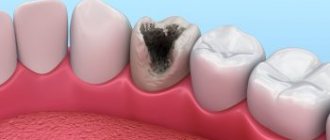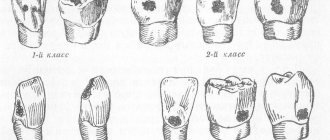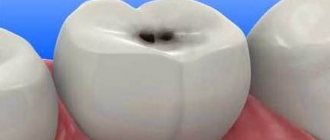Caries is a dental disease that develops in hard tissues and gradually leads to their destruction. Ignoring this problem can lead to the appearance of pulpitis or periodontitis, so the disease should be treated in the early stages. For oral health, it is also recommended to carry out preventive procedures. In addition to standard brushing with toothpaste, there are many traditional methods that can be used at home to treat dental caries . They effectively help prevent the onset and development of the disease, as well as temporarily eliminate its unpleasant symptoms.
How does caries develop?
Caries is a pathological process that destroys the hard tissues of the tooth. By its nature, it is sluggish and usually occurs under the influence of negative environmental factors or internal problems of the body. Bacteria in the oral cavity produce organic acid that corrodes the enamel, which leads to the development of pathology. The more bacteria, the more acid and, accordingly, the greater the damage.
In this article
- How does caries develop?
- Is it possible to remove caries at home?
- How to remove caries at home using folk remedies?
- What is effective against caries at home?
- The influence of dietary habits on caries
- Good immunity reduces the risk of developing caries
- How to brush your teeth and how to rinse your mouth to prevent caries
- Don't forget about professional hygiene
- Conclusion
Often the disease begins under the surface of the tooth, so in the absence of pronounced symptoms, it is not always possible to notice it at an early stage without the help of a doctor. Early caries looks like a white dot on the enamel surface. At the same time, most people imagine carise as a huge hole in the tooth. Therefore, often a person with early caries does not suspect that a pathological process has begun in his tooth.
A person can know that there is caries in a tooth when the carious cavity expands to the upper part of the tooth or when acute toothache signals this. The most correct and safe option for any dental problems is to contact a dental clinic as quickly as possible. But if for some reason this is not possible, people are looking for a way to cure tooth decay on their own.
conclusions
Caries is a rather unpleasant disease that, when neglected, leads to complete tooth destruction without the possibility of restoration. Prevention, including traditional methods, proper care and a healthy diet minimize the risk of the problem occurring. However, all these methods do not replace treatment, but are only an addition to it. Therefore, when caries occurs, it is necessary, first of all, to seek professional help.
Calculator: calculate prices online
Light-curing fillings, caries treatment
The price is ALL INCLUSIVE except anesthesia, if necessary
Select the type of filling
0
Specify the number of fillings
Is it possible to remove caries at home?
This question may arise in the following cases:
- a person is afraid of dentists and is willing to risk his dental health rather than go to the doctor;
- there is no opportunity to visit a doctor for objective reasons (for example, on a long trip or when there is no good clinic nearby);
- a small child resists dental treatment in the dentist's office;
- no money for dental treatment.
In most cases, it is impossible to get rid of caries at home.
But there are medicinal methods that help strengthen the enamel and stop the pathological process at an early stage, when caries looks like a white speck on the enamel. To do this, use gels that restore enamel and means for its remineralization.
You can use these anti-caries remedies at home, but a dentist must prescribe them and monitor the process.
Causes of destruction of hard tissues
Here are the main provoking factors for the occurrence of a harmful process - demineralization:
- unhealthy diet (excess fast carbohydrates and sugar);
- aggressive liquids (carbonated lemonades, energy drinks, concentrated juices);
- diseases of the endocrine system;
- mechanical damage (bruxism, impacts, biting hard foods);
- the chemical composition of saliva and its consistency;
- insufficient hygiene.
How can you strengthen your teeth enamel? This question is relevant for many. If some factors (for example, poor hygiene) are easy to eliminate, then others, one way or another, will have to be taken into account and their impact reduced in accessible ways.
How to remove caries at home using folk remedies?
In addition to the medicinal approach, there are a lot of popular recommendations on how to get rid of caries at home. Here are a few recipes that traditional medicine offers:
- Rinse your mouth with sage infusion.
One tablespoon is poured with boiling water, the broth is left for about an hour, and then a cotton swab is moistened in the resulting infusion and applied to the affected tooth. After this, you need to rinse your teeth and mouth with sage. Dentists note that sage is indeed a natural antiseptic and can prevent the growth of bacteria. But this remedy does not help cure dental caries at home; it can only temporarily slow down the process or serve as a preventive measure for caries.
- Apply fir oil to the tooth.
Another popular recommendation is to apply a cotton swab with fir oil to the sore tooth. You will not be able to remove caries with this remedy on your own, but it can temporarily provide a good analgesic effect. You should make an appointment with a doctor as soon as possible, because pain in the teeth may indicate complicated caries or pulpitis.
- Garlic.
There are many folk tips for home treatment of caries using garlic. It is recommended to apply it to the tooth, lean it against the cheek on the side of the diseased tooth, and soak the enamel with juice. And although garlic’s ability to destroy microbes is beyond doubt, it is powerless in the fight against tooth decay. At best, it will partially relieve pain, but it certainly will not help cure deep caries.
- Onion peel.
To treat caries at home, it is suggested to prepare a decoction of onion peels, leave it for several hours and use it as a mouth rinse. The infusion has an antiseptic effect and slightly dulls the pain. There are dozens of other folk recipes that suggest rinsing your mouth, applying something to tooth enamel, or rubbing it into your gums.
- Self-medication is dangerous and unprofitable
It is important to treat any folk remedies critically and remember that their use not only does not guarantee recovery, but can sometimes be dangerous. For example, tinctures for rinsing with alcohol cause damage to the mucous membrane, ulcers and tissue erosion.
You must understand that the development of caries in most cases can be stopped only by removing damaged tooth tissue and filling the cavity. No herbal infusion can cope with this task.
Trying to cure caries at home, a person triggers the pathological process to such an extent that serious complications can arise, and caries spreads to the soft tissues of the tooth. And then, in any case, it will not be possible to avoid visiting the dentist, only the treatment process will be longer, more painful and will require significant financial costs.
SALT BANDAGES TREAT ALMOST EVERYTHING. TREATMENT WITH SALT BANDAGES
In medical practice, a 10% solution of table salt (rock and no other) is usually used, that is, 100 g per 1 liter of water.
For the treatment of the liver, pancreas, spleen, kidneys and for headbands, it is better to use an 8-9 percent solution (80-90 g of salt per 1 liter of water). Salt for the solution must be taken strictly by weight, keep the container (jar) with the solution closed so that it does not evaporate and does not change its concentration.
Not all water is suitable for preparing a hypertonic solution. Spring, artesian, and sea water are not suitable for this purpose, especially water containing iodine salts, which neutralize table water in solution. It is better to use distilled (from a pharmacy) water or, in extreme cases, purified rain or snow water to prepare the saline solution.
The salt dressing is made only from hygroscopic, well-wetted cotton material - repeatedly washed, not new, not kitchen or starched “waffle” towels in 3-4 layers and thin, also well-wetted, medical gauze in 8-10 layers, and also hygroscopic, preferably viscose, cotton wool for tampons.
1. For headaches caused by inflammatory processes, dropsy, swelling of the brain and meninges (meningitis, arachnoiditis), diseases of other organs, for example, influenza, sepsis, typhoid, excessive blood supply from intense mental and physical work, after a stroke, as well as for tumor formations in the brain, a saline bandage in the form of a cap or a wide strip of bandage in 8-10 layers, soaked in a 9 percent solution and slightly squeezed out, is applied to the entire (or around) head and must be bandaged over the entire surface of the bandage with one small gauze bandage. A dry scarf is tied on top, in 2 layers, preferably a cotton or old gauze scarf. The bandage is applied overnight, for 8-9 hours, until dry, and removed in the morning.
FOR CEREBRAL VASCULAR SCLEROSIS, SALT BANDAGE IS CONTRAINDICATED!
Salt dressing for runny nose, sinusitis and sinusitis. 2. For runny nose, sinusitis, frontal sinuses, the bandage is made in the form of a gauze strip in 6-7 layers on the forehead (for sinusitis), on the nose and cheeks with cotton swabs placed on the wings of the nose, pressing the strip to the skin of the face in these places. These strips are bandaged with two or three turns of a small bandage, last for 7-8 hours, and are used until healing. During the day, the mouth and nose should be rinsed 2-3 times with a solution of a weaker concentration: 1.5 heaped teaspoons of salt per glass (250 ml) of water, from the tap.
Salt bandage for caries 3. Dental caries is also treated with a gauze strip in 8 layers, soaked in a 10% salt solution, on the entire jaw with a diseased tooth and bandaged with 2-3 turns of a small bandage in a circular manner. It is applied overnight, the course of treatment is 1-2 weeks, after which the diseased tooth should be filled. Caries and periodontal disease can be treated with salt: after dinner, before going to bed, hold a sip of a 10 percent saline solution in your mouth for 5-7 minutes and spit, after which do not take anything into your mouth. For toothache, even under a crown, this procedure can be repeated several times.
For caries complicated by granuloma, as well as for fluxes on a diseased tooth, on the gum (behind the cheek) you can apply a thick cotton swab (preferably viscose) as thick as a finger, soaked in a 10 percent solution and squeezed almost dry.. You need a swab. keep it all night.
Salt bandage for sore throat. 4. Sore throat, laryngitis, tracheitis, inflammation of the salivary and thyroid glands (goiter) are well treated with a saline gauze bandage in 6-7 layers (from a wide bandage), soaked in a 10% salt solution, applied to the neck overnight, and for headaches pain in the form of the same strip - and on the head. Both of these strips (or one common one, extended to the neck and head) are bandaged with one small gauze bandage. The lower edge of the bandage on the neck (so as not to wrap up) is bandaged to the body with one turn of the bandage through the armpits of both arms and the back, and the bandaging is completed on the neck without squeezing the breath.
Salt dressing for bronchitis 5. For pneumonia, bronchitis, pleurisy, emphysema, asthma of infectious origin, lung tumors, a dressing with a 10% solution is applied to the entire back, always to the site of the disease, and even to the entire chest (for men) from two “waffle” towels folded in two layers across each. One is soaked in a slightly warmed saline solution, slightly squeezed out (the squeezed solution is poured back into the jar, it does not spoil), the same dry one is applied to the wet one in two layers and both are bandaged quite tightly, without squeezing the breath, with two large gauze bandages. The upper half of the back and shoulder girdle are bandaged in the form of a transverse figure eight through the armpits of both arms, the lower half is bandaged with a second bandage around the lower half of the chest. Bandaging is performed over the entire surface of the towels. The course of treatment for inflammatory processes of the lung is 7-10 dressings daily, for tumors - 3 weeks, one of them - daily, the remaining 14 dressings - every other night. These dressings also last 10 hours before drying.
Salt dressing for mastopathy, adenoma, cancer of one breast. 6. For mastopathy, adenoma, cancer of one breast, a bandage with a 9-10 percent solution is made from one “waffle” towel, folded in 3-4 layers across, with a strip 25 cm wide. If there is a wound, it is covered with a gauze cloth with a solution in 2-4 layers, which is covered with a towel, and together they are bandaged with one large gauze bandage, without squeezing the breath.
Mastopathy and other inflammatory processes of the mammary glands are treated with a bandage for one to two weeks, tumors - for 3 weeks (the first - daily, the rest - every other night). It is performed at night and lasts 9-10 hours.
Saline dressing for heart disease. 7. In case of inflammation of the heart muscle and membranes of the heart (with myocarditis, endocarditis, pericarditis), in a 9% saline solution heated to 70 °C, only the ends of a strip of “waffle” towel, folded lengthwise in 3 layers, are wetted (and squeezed out), which is thrown over over the left shoulder, they cover the heart in front and behind (between the shoulder blades), and these ends are bandaged with one wide gauze bandage around the chest. This dressing is performed at night every other day for 2 weeks.
Angina pectoris, coronary artery disease, and heart valve defects are not cured by a saline dressing.
Salt dressing for cholecystitis, hepatitis, cirrhosis, gastritis and pancreatitis. 8. For cholecystitis, hepatitis, cirrhosis, gastritis and pancreatitis, the same bandage of a “waffle” towel in 3-4 layers across a strip 25 cm wide, and for dropsy of the abdomen and for the entire abdomen, is performed around the lower half of the chest and the upper half abdomen (from the base of the mammary glands in women and nipples in men to the navel). This bandage is bandaged with one or two wide bandages. It also lasts 9-10 hours. The course of treatment is 7-10 dressings.
The bandage does not cure stomach ulcers, duodenal ulcers, hernias, scars, adhesions, constipation, volvulus, and does not resolve stones.
9. Inflammation of the intestinal mucosa - enteritis, colitis, appendicitis - a salt bandage on the entire abdomen at night using a towel in 3-4 layers successfully treats within one week. In case of poisoning, for example, from poor quality food, 3-4 bandages for 9-10 hours are enough, for children - 1-2 bandages for the same period of time, so that the intestines are cleared of poisons.
To stop diarrhea for the same reason in adults, two sips of a 9-10 percent salt solution are enough, preferably on an empty stomach, with an interval of 1-2 hours.
10. Pathologies of the pelvic organs - colitis, polyps, rectal tumors, hemorrhoids, prostatitis, prostate adenomas, inflammation and tumors of the pelvic organs - fibroids, fibroids, cancer of the uterus and ovaries, as well as inflammation of the mucous membrane of the bladder and hip joints are treated with saline a bandage of two “waffle” towels. One, folded in 2 layers lengthwise, is moistened in a heated 10% solution, squeezed out medium, applied to the pelvic girdle, covered with the same second towel in 2 layers, and both are bandaged quite tightly with two wide gauze bandages. In the inguinal pits, with one turn of the bandage around the thighs, dense rollers are bandaged, which press the bandage to the body in these depressions and are secured to the bandage with pins. This bandage should cover the lower abdomen of the patient (sick) from the navel to the pubis inclusive in front and the sacrum and buttocks from the middle of the lower back to the anus in the back. Inflammatory processes in the organs of this department should be treated for 2 weeks, tumors - 3, and in both cases, in the first week the bandage is applied every day, the rest are performed every other night.
The influence of dietary habits on caries
The destruction of the enamel structure is facilitated by the acid secreted by bacteria. It is formed in large quantities when consuming carbohydrate foods. Therefore, to prevent caries, it is necessary to limit the consumption of sweets and sugar, and after eating sweet foods, be sure to rinse your mouth.
Caries develops faster when the enamel becomes thinner. In order for teeth to be strong and less susceptible to decay, the body must receive sufficient amounts of vitamins and microelements. They can be taken as a multivitamin as prescribed by your doctor, but it is best to take them through food. To do this, the diet must be varied and balanced, it must contain dairy products, fish, cheese, and fresh herbs.
It is useful to eat solid vegetables and fruits (carrots, apples). They mechanically clean the enamel from plaque and stimulate blood flow in the gums. Avoid eating foods and drinks that are too hot or too cold. Due to temperature changes, microscopic cracks form on the enamel, which contributes to the development of caries.
Good immunity reduces the risk of developing caries
The bacteria that cause tooth decay are part of the normal microflora of the oral cavity. But with weakened immunity and other accompanying factors, they can cause caries. At home, everyone can prevent this dental disease by strengthening the immune system. This is facilitated by hardening, reducing stress levels, quality sleep at night, proper nutrition, giving up bad habits, and maintaining a normal weight.
The fewer factors that weaken the immune system, the lower the risk of dental caries.
Fissure sealing is a way to prevent or slow down caries in a child
Caries in a child can be stopped by fissure sealing. Fissures are the natural grooves and grooves on the chewing surface of the teeth. The anatomical features of their structure are such that food debris is easily retained in the fissures, and the process of enamel mineralization is slower than in other areas of the teeth.
To prevent dental caries (most often in children, but the method is also applicable for adults), fissures are sealed. The essence of the method is that natural grooves are covered with special dental sealants containing calcium and fluoride. Sealants seal the tooth, preventing the impact of cariogenic factors on it, and the mineral components included in the composition nourish the dental tissues.
The main indication for sealing is deep fissures that are difficult to clean during daily oral hygiene.
It is optimal for a child to seal the grooves on the teeth six months after teething. At about 6-8 years old, the child’s permanent teeth begin to be sealed - first the first molars, closer to 10 years - the premolars, and by the age of 12-13 - the second molars.
Sealing is not carried out if caries has already formed in the fissures - like a stain or a cavity in the tooth.
The sealing procedure can be invasive or non-invasive; the technology is selected by the doctor individually for each patient. If the fissure is clearly visible, it is sealed using a non-invasive method: the tooth is cleaned of plaque, treated with a special gel that ensures reliable fixation of the filling, sealant is applied and illuminated with a lamp. For narrow and deep fissures, the bottom and walls of which are difficult to see to ensure the absence of caries, the dentist chooses an invasive sealing method.
After cleaning the tooth, the fissures are opened with a drill and their condition is assessed. In the absence of carious lesions, further sealing is carried out similarly to the non-invasive method. Fissure sealing is one of the most effective ways to prevent caries in chewing teeth.
How to brush your teeth and how to rinse your mouth to prevent caries
Everyone can take care of their dental and oral health without leaving home. To do this, you must follow the rules of hygiene:
- Brush your teeth twice a day using the correct technique for at least two to three minutes.
- Use fluoride toothpaste (if recommended by your dentist).
- After brushing your teeth, be sure to use dental floss to remove food debris and plaque from the interdental spaces.
- Using an irrigator helps to achieve the maximum degree of cleanliness. This device creates a powerful stream of water that removes dirt from areas of the mouth where a toothbrush cannot reach.
- It is important to brush not only your teeth, but your tongue and the inside of your cheeks. Plaque also accumulates on them and bacteria that cause caries multiply.
- Use special rinses after cleaning. They have an antimicrobial effect, preventing the proliferation of pathogenic microorganisms in the oral cavity.
Don't forget about professional hygiene
No matter how carefully you take care of your oral cavity at home, you need to undergo a professional cleaning procedure at the dentist twice a year. In a clinical setting, you can effectively remove complex dental deposits and restore the normal mineral balance of tooth enamel. If you wear braces, professional cleaning should be done at least three times a year.
Professional oral hygiene and further care at home along with other caries prevention measures will help to reliably protect tooth enamel from destruction.
Clinical researches
According to clinical studies of the Asepta series of products, a fairly high effectiveness of a number of drugs for moderate periodontitis was revealed. In addition, when using them, neither irritation of the mucous membrane nor brown staining of fillings was recorded.
Sources:
- Clinical and laboratory assessment of the influence of domestic therapeutic and prophylactic toothpaste based on plant extracts on the condition of the oral cavity in patients with simple marginal gingivitis. Doctor of Medical Sciences, Professor Elovikova T.M.1, Candidate of Chemical Sciences, Associate Professor Ermishina E.Yu. 2, Doctor of Technical Sciences Associate Professor Belokonova N.A. 2 Department of Therapeutic Dentistry USMU1, Department of General Chemistry USMU2
- The effectiveness of the use of Asept “adhesive balm” and Asept “gel with propolis” in the treatment of chronic generalized periodontitis and gingivitis in the acute stage (Municipal Dental Clinic No. 4, Bryansk, Kaminskaya T. M. Head of the therapeutic department Kaminskaya Tatyana Mikhailovna MUZ City Dental Clinic No. 4, Bryansk
- Study of the clinical effectiveness of treatment and prophylactic agents of the Asepta line in the treatment of inflammatory periodontal diseases (A.I. Grudyanov, I.Yu. Aleksandrovskaya, V.Yu. Korzunina) A.I. GRUDYANOV, Doctor of Medical Sciences, Prof., Head of Department I.Yu. ALEXANDROVSKAYA, Ph.D. V.Yu. KORZUNINA, asp. Department of Periodontology, Central Research Institute of Dentistry and Maxillofacial Surgery, Rosmedtekhnologii, Moscow
- The role of anti-inflammatory rinse in the treatment of periodontal diseases (L.Yu. Orekhova, A.A. Leontyev, S.B. Ulitovsky) L.Yu. OREKHOVA, Doctor of Medical Sciences, Prof., Head of Department; A.A. LEONTIEV, dentist; S.B. ULITOVSKY, Doctor of Medical Sciences, Prof. Department of Therapeutic Dentistry of St. Petersburg State Medical University named after. acad. I. P. Pavlova
- Report on the determination/confirmation of the preventive properties of personal oral hygiene products “ASEPTA PLUS” Remineralization doctor-researcher A.A. Leontyev, head Department of Preventive Dentistry, Doctor of Medical Sciences, Professor S.B. Ulitovsky First St. Petersburg State Medical University named after. acad. I.P. Pavlova, Department of Preventive Dentistry
- Clinical studies of antisensitive toothpaste “Asepta Sensitive” (A.A. Leontyev, O.V. Kalinina, S.B. Ulitovsky) A.A. LEONTIEV, dentist O.V. KALININA, dentist S.B. ULITOVSKY, Doctor of Medical Sciences, Prof. Department of Therapeutic Dentistry, St. Petersburg State Medical University named after. acad. I.P. Pavlova

